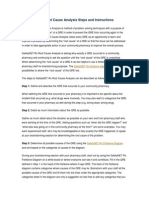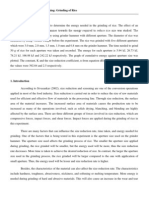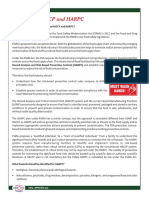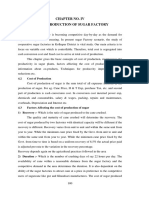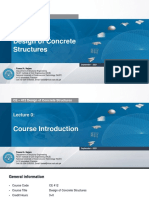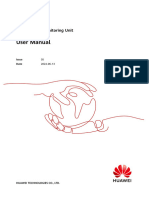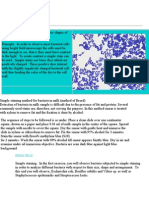Purpose: Premier Plastic Production Company Sop For Emergency Response Plan & Preparedness
Purpose: Premier Plastic Production Company Sop For Emergency Response Plan & Preparedness
Uploaded by
imranul haqCopyright:
Available Formats
Purpose: Premier Plastic Production Company Sop For Emergency Response Plan & Preparedness
Purpose: Premier Plastic Production Company Sop For Emergency Response Plan & Preparedness
Uploaded by
imranul haqOriginal Title
Copyright
Available Formats
Share this document
Did you find this document useful?
Is this content inappropriate?
Copyright:
Available Formats
Purpose: Premier Plastic Production Company Sop For Emergency Response Plan & Preparedness
Purpose: Premier Plastic Production Company Sop For Emergency Response Plan & Preparedness
Uploaded by
imranul haqCopyright:
Available Formats
PREMIER PLASTIC PRODUCTION COMPANY
SOP FOR EMERGENCY RESPONSE PLAN & PREPAREDNESS
DOCUMENT CODE: 004 DOCUMENT STATUS: RELEASED
ISSUE DATE :26/06/2023 CREATED BY: HSSE DEPARTMENT
REVISION DATE: APPROVED BY: GENERAL MANAGER
REVISION NUMBER: 02 RECHECKED BY: COMMMERCIAL MANAGER
1. PURPOSE
This procedure outlines the activities and responsibilities of employees in the event of an emergency. The Emergency
Action & Response Plan is designed to ensure the following:
The identification and notification of an emergency condition so that all employees are aware of the situation
The evacuation and accounting of all PREMIER PLASTIC PRODUCTION COMPANY employees, visitors, contractors.
Establishment of an incident commander to ensure an effective and coordinated effort to bring the emergency
situation under control.
2. SCOPE
This procedure applies to emergency situations including but not limited to medical, fire, spills, power outages, and
weather emergencies. In addition, this procedure applies to all PREMIER PLASTIC PRODUCTION COMPANY employees,
contract employees, and emergency response personnel.
3. RESPONSIBILITY
HSE Coordinator:
Ensure that this plan is reviewed annually to confirm plan is still adequate and communicated via training with
all plant personnel.
Ensure that critical staff personnel review the procedures with new employees and new contractors before they
begin active work at PREMIER PLASTIC PRODUCTION COMPANY.
Ensure that the PREMIER PLASTIC PRODUCTION COMPANY Management team receives training related to this
procedure and ensures that there are a reasonable number of employees trained to meet the minimum
requirements of this procedure as an incident commander.
Managers & Supervisors:
Be knowledgeable of this procedure and shall be able to fulfill the role of an incident commander in the event of
an emergency.
Initiate a review of the emergency plan after an incident, drill, on-site process change, or change in the
surrounding community that may alter the planned response.
Employees:
Assist in emergency response activities as directed by the PREMIER PLASTIC PRODUCTION COMPANY
Management Team.
Complete required training and demonstrate an understanding of this procedure.
Familiar with the locations of alarm switches or alarm pull stations in their work area and understand how to
activate the alarm system.
PPC/HSSE/SOP/004/REV 2 DATED 26 JUNE, 2023 Page 1 of 19
“Printed copies of this document are uncontrolled”
PREMIER PLASTIC PRODUCTION COMPANY
SOP FOR EMERGENCY RESPONSE PLAN & PREPAREDNESS
DOCUMENT CODE: 004 DOCUMENT STATUS: RELEASED
ISSUE DATE :26/06/2023 CREATED BY: HSSE DEPARTMENT
REVISION DATE: APPROVED BY: GENERAL MANAGER
REVISION NUMBER: 02 RECHECKED BY: COMMMERCIAL MANAGER
4. DEFINITIONS
Emergency Events including but not limited to medical, fire, spills, power outages, and weather
emergencies.
Spill uncontrolled release of a liquid or solid from a container, drum, pipe or tank
Uncontrolled any flow state that has 1) potential energy, like pressure, that is not controlled; 2) no positive
method of shut off, as in the case of a broken sample line; or 3) container overflow as in a
tank running over capacity
5. GENERAL PROCEDURES
5.1 Management approval and commitment
5.1.1 Management commitment
Facility Management has committed to dedicate resources to respond to emergencies that may occur on-site.
An emergency notification system has been established consisting of audible alarms and siren system.
5.1.2 Program Evaluation & Approval
The emergency response plan shall be reviewed and evaluated at least annually or as necessary or after an
incident or drill that may alter the planned process or after an onsite process change that may alter the planned
response or after a change in the surrounding community that may alter the planned response.
5.2 Emergency Response Management Structure Emergencies
In a spill, medical or other form of emergency, members of management can provide knowledge and leadership to:
a. Evaluate the risk for potential of a spill, additional injuries and offsite impacts.
b. Determine the best methods to contain or eliminate hazards.
c. Assess and recommend strategy to resolve emergency situational conditions.
d. In a spill event; recommend proper procedures for containerizing waste generated from clean-up activities.
Refer to Attachment A1, A2 and L for response personnel.
5.3 Response Procedures
5.3.1 Major Medical Emergencies
Major medical emergencies involve those cases that cannot be treated with basic first aid procedures like severe
cuts, severe falls, heart attacks, etc. Prompt and immediate action is key to potentially saving a life.
Refer to Attachment B for procedures on responding to a major medical emergency.
PPC/HSSE/SOP/004/REV 2 DATED 26 JUNE, 2023 Page 2 of 19
“Printed copies of this document are uncontrolled”
PREMIER PLASTIC PRODUCTION COMPANY
SOP FOR EMERGENCY RESPONSE PLAN & PREPAREDNESS
DOCUMENT CODE: 004 DOCUMENT STATUS: RELEASED
ISSUE DATE :26/06/2023 CREATED BY: HSSE DEPARTMENT
REVISION DATE: APPROVED BY: GENERAL MANAGER
REVISION NUMBER: 02 RECHECKED BY: COMMMERCIAL MANAGER
5.3.2 Minor Injuries, Illnesses
Most accident and first aid response situations will be for minor injuries. Minor injuries can be immediately
attended to by trained first aid responders but will often need additional medical follow up by external medical
providers.
Refer to Attachment C for procedures on responding to a minor injury Refer to Attachment J for a list of first aid
team members.
5.3.3 Fire Emergencies
The protection of personal safety is the first and foremost goal of the action plan for handling fire emergencies.
Refer to Attachment D for procedures on responding to a fire emergency.
5.3.4 Workplace Violence Threats
Workplace violence can be the result of domestic instability, emotional duress, hatred, and crime. Every
employee needs to be vigilant to protect against workplace violence.
Refer to Attachment F for procedures on responding to threats of workplace violence.
5.3.5 Bomb Threats
Although bomb threats are typically seen as pranks, concerns about terrorism and domestic violence have made
it important that all bomb threats be taken seriously.
Refer to Attachment G for procedures on responding to bomb threats.
5.3.6 Weather Emergencies
Serious inclement weather can impact production and threaten the health and safety of all personnel on-site.
Refer to Attachment H for procedures on responding to weather emergencies.
5.3.7 Spill Emergency Response Management
During a spill event, the primary concerns are for the safety and health of all personnel on-site and to the
environment. Under no circumstances should any potentially contaminated liquids be allowed to enter public
sewers, drainage systems or natural waterways
In a spill emergency, the Spill Team members can provide knowledge and leadership to:
Evaluate the risk potential of a spill
Determine the best methods to use to contain hazards
Assess and recommend a clean-up strategy
Recommend proper procedures for containerizing waste generated from clean-up activities
PPC/HSSE/SOP/004/REV 2 DATED 26 JUNE, 2023 Page 3 of 19
“Printed copies of this document are uncontrolled”
PREMIER PLASTIC PRODUCTION COMPANY
SOP FOR EMERGENCY RESPONSE PLAN & PREPAREDNESS
DOCUMENT CODE: 004 DOCUMENT STATUS: RELEASED
ISSUE DATE :26/06/2023 CREATED BY: HSSE DEPARTMENT
REVISION DATE: APPROVED BY: GENERAL MANAGER
REVISION NUMBER: 02 RECHECKED BY: COMMMERCIAL MANAGER
The senior spill team member will lead spill team response efforts.
A Spill Team has been established to pool resources from production and distribution in response to emergencies
within the PREMIER PLASTIC COMPANY premises. A listing of current Spill Team Members is located in
Attachment J.
5.3.8.1 Spill Response with On-Site Resources
During a spill event, the primary concerns are for the safety and health of all personnel on-site and to the
environment.
Refer to Attachment E for procedures in responding to spills.
5.4 Facility Information
The Premier Plastic Company facility is located at New Industrial Area, Street 2, Zone No. 81. All Machinery operation is
done at production floors inside buildings and bulk loading and unloading occurs in the north Side. Unauthorized access
to these areas is restricted by gated entrance.
A facility plot plan indicating storage locations of significant materials, response equipment and location of utility
isolation points is located in Attachment I.
5.5 Post Emergency Investigation
5.5.1 Incident Reports & Investigation
Following a spill or emergency response on-site, an incident or spill report must be completed within 48 hours of
the incident.
Root cause and corrective actions are to be identified on the report.
Incident reports will be reviewed with the team members involved.
Refer to HSSE SOP 017 for additional reporting procedure for work related injuries.
The investigation shall determine the root cause(s) of the event, and identify corrective actions that shall be
implemented to prevent a reoccurrence, including assignment of resources and deadlines for completion.
Representatives shall verify that corrective actions have been implemented.
The information gained from experiences relating to emergency response planning shall be appropriately
shared
6. TRAINING
6.1 Content
Spill Team members shall be trained in the content of this procedure with a review of MSDS, PPE usage and spill
response equipment availability.
PPC/HSSE/SOP/004/REV 2 DATED 26 JUNE, 2023 Page 4 of 19
“Printed copies of this document are uncontrolled”
PREMIER PLASTIC PRODUCTION COMPANY
SOP FOR EMERGENCY RESPONSE PLAN & PREPAREDNESS
DOCUMENT CODE: 004 DOCUMENT STATUS: RELEASED
ISSUE DATE :26/06/2023 CREATED BY: HSSE DEPARTMENT
REVISION DATE: APPROVED BY: GENERAL MANAGER
REVISION NUMBER: 02 RECHECKED BY: COMMMERCIAL MANAGER
Employees assigned a response role shall be trained accordingly.
The general procedures shall be reviewed with all employees in formats such as drills, instructor-led or computer
based training sessions.
6.2 Frequency
Employees shall be trained on the contents of this SOP upon initial response/job assignment and when
procedures/conditions change or as needed.
At least one response scenario shall be tested and documented each year (i.e. fire drill, spill response, tornado).
7. RECORDKEEPING & REFERENCES
Training records shall be maintained in the training files.
Documentation of emergencies, spills and releases, follow up critiques, and training will be maintained in the
files.
This procedure shall be reviewed at least annually or updated as necessary to reflect accurate emergency
response information.
This emergency plan shall be maintained at the facility, readily available in event of an emergency incident.
Emergency drill report form PPC/HSSE/ERP/F 039/Rev. 0 Dated 14/12/2022
8. ATTACHMENTS
A.1 Phone List F Workplace Violence Response
A.2 Notification/Response Matrix G Bomb Threats
B Major Medical Response H Weather Emergencies
C Minor Injury Response I Facility Map
D Fire Emergency Response J Emergency Response Team Members
E Spill Response
Attachment A.1
PREMIER PLASTIC COMPANY
PPC/HSSE/SOP/004/REV 2 DATED 26 JUNE, 2023 Page 5 of 19
“Printed copies of this document are uncontrolled”
PREMIER PLASTIC PRODUCTION COMPANY
SOP FOR EMERGENCY RESPONSE PLAN & PREPAREDNESS
DOCUMENT CODE: 004 DOCUMENT STATUS: RELEASED
ISSUE DATE :26/06/2023 CREATED BY: HSSE DEPARTMENT
REVISION DATE: APPROVED BY: GENERAL MANAGER
REVISION NUMBER: 02 RECHECKED BY: COMMMERCIAL MANAGER
Critical Phone Numbers
Emergency Contact Information
Police, Fire, Ambulance 999
Kahrama 991
Ashgal 188
Facility Management Contact Information
Emergency Coordinator (primary) Imranul haque (HSE Personnel) 55872822
Emergency Coordinator (alternative) Badarul Muneer 66691642
HSE Coordinator Imranul Haque 55872822
Production Manager Khaiyam Akhtar 33256030
Plant Engg (Thermoforming) Md. Shuaib 33016057
Plant Engg (PET) Saeed Ahmed 55616409
HR-Manager Md. Farook 33196619
Commercial Manager Aliasgar Kapasi 66192665
Utilities Contact Information
Natural gas Woqod 40217777
Sewage and waste Alcat 55517353
Generator SGS
Fire Alarm AMC Service Thermal Arabia 66880994
Environmental Emergency Contact Information
Spill Response Contractor Power Waste 70197318
Attachment A.2
RED Numbers Indicate Notification Order for Calling ALL Indicated Personnel
PPC/HSSE/SOP/004/REV 2 DATED 26 JUNE, 2023 Page 6 of 19
“Printed copies of this document are uncontrolled”
PREMIER PLASTIC PRODUCTION COMPANY
SOP FOR EMERGENCY RESPONSE PLAN & PREPAREDNESS
DOCUMENT CODE: 004 DOCUMENT STATUS: RELEASED
ISSUE DATE :26/06/2023 CREATED BY: HSSE DEPARTMENT
REVISION DATE: APPROVED BY: GENERAL MANAGER
REVISION NUMBER: 02 RECHECKED BY: COMMMERCIAL MANAGER
Personnel with an * beside their call order are not to be contacted unless directed by Management
Khaiyam Saeed Ahmed/Md. Md. Farook Imranul Imranul Imranul Aliasgar Kapasi
Akhtar Shuaib Haque Haque Haque
Prod. Mgr. Plant Engg Mgr. - HR HSE Coord. Emergency Hazardous Commercial
Response waste Manager
Medical
emergency or 2 3 4 1 5*
injury
On-site violence
2 3 4 1
Bomb threat
3 4 2 1
Spills and release
3 2 1
Fire incident
3 2 4 1 5*
Major weather
disaster 2 3 4 1
Power failure
2 1 3
Major equipment
failure 3 1 2
Local/National
emergency 2 3 1 2
affecting Plant
Attachment B
PPC/HSSE/SOP/004/REV 2 DATED 26 JUNE, 2023 Page 7 of 19
“Printed copies of this document are uncontrolled”
PREMIER PLASTIC PRODUCTION COMPANY
SOP FOR EMERGENCY RESPONSE PLAN & PREPAREDNESS
DOCUMENT CODE: 004 DOCUMENT STATUS: RELEASED
ISSUE DATE :26/06/2023 CREATED BY: HSSE DEPARTMENT
REVISION DATE: APPROVED BY: GENERAL MANAGER
REVISION NUMBER: 02 RECHECKED BY: COMMMERCIAL MANAGER
Major Medical Emergency Response
Major medical emergencies involve those cases that cannot be treated with basic first aid procedures like
severe cuts, severe falls, heart attacks, etc. Prompt and immediate action is key to potentially saving a life.
Take the following actions anytime an employee, contractor, truck driver or visitor shows signs of profuse bleeding, loss
of consciousness, difficulty in breathing, trauma and other serious medical symptoms.
1) Call for First Aid Assistance
Inform your Supervisor or your colleague. Announce the following:
“FIRST AID EMERGENCY! HELP NEEDED AT __________”
* * * * * repeat * * * * *
“FIRST AID EMERGENCY! HELP NEEDED AT __________”
2) Dial 9-9-9 to Initiate Emergency Medical Response
Be prepared to provide the following information:
→ Name: <<Your Name>>
→ Location: Premier Plastic Production Company (Islamic Hypochlorite)
→ Contact Phone: (974)
→ Nature of Extent of Injury
Emergency: Breathing (yes or no)
Conscious (yes or no)
Nature of accident (if applicable)
Do not hang up the phone unless instructed to do so by the 999 operator.
Assist first aid responders to comfort and aid the injured or ill employee.
Direct a co-worker or guard to attend the gate so that the emergency vehicle will have immediate
access to the facility.
3) When in Doubt, Pull the Fire Alarm
In the event that you are the injured person and no one else can see you or if you are unable to
perform the duties above for whatever reason.
This will cause a response, no matter the emergency.
PPC/HSSE/SOP/004/REV 2 DATED 26 JUNE, 2023 Page 8 of 19
“Printed copies of this document are uncontrolled”
PREMIER PLASTIC PRODUCTION COMPANY
SOP FOR EMERGENCY RESPONSE PLAN & PREPAREDNESS
DOCUMENT CODE: 004 DOCUMENT STATUS: RELEASED
ISSUE DATE :26/06/2023 CREATED BY: HSSE DEPARTMENT
REVISION DATE: APPROVED BY: GENERAL MANAGER
REVISION NUMBER: 02 RECHECKED BY: COMMMERCIAL MANAGER
Attachment C
Minor Medical Emergency Response
Most accident and first aid response situations will be for minor injuries. Minor injuries can be immediately
attended to by trained first aid responders but will always need addition medical follow up by external
medical providers.
Take the following actions anytime an employee, contractor, truck driver or visitor shows needs medical attention for a
minor injury.
1) Call for First Aid Assistance
Inform your Supervisor or your colleague. Announce the following:
“FIRST AID EMERGENCY! HELP NEEDED AT __________”
* * * * * repeat * * * * *
“FIRST AID EMERGENCY! HELP NEEDED AT __________”
A first aid team member and/or a Supervisor and/or the Management Team members will report to
the area where the injured is located.
First aid will be provided by the first aid team member.
2) Evaluation for Additional Medical Treatment
The injured, the Production Manager and/or Supervisor will determine if additional medical
evaluation or treatment is needed.
If further medical evaluation or treatment is needed, the Supervisor will arrange transportation to
Occupational Clinic or Hospital Emergency Room. HSSE SOP 17– Reporting and Investigating Injuries
fire additional information about sending injured workers to these medical facilities.
PPC/HSSE/SOP/004/REV 2 DATED 26 JUNE, 2023 Page 9 of 19
“Printed copies of this document are uncontrolled”
PREMIER PLASTIC PRODUCTION COMPANY
SOP FOR EMERGENCY RESPONSE PLAN & PREPAREDNESS
DOCUMENT CODE: 004 DOCUMENT STATUS: RELEASED
ISSUE DATE :26/06/2023 CREATED BY: HSSE DEPARTMENT
REVISION DATE: APPROVED BY: GENERAL MANAGER
REVISION NUMBER: 02 RECHECKED BY: COMMMERCIAL MANAGER
Attachment D
Fire Emergency Response
The protection of personal safety is the first and foremost goal of the action plan for handling fire emergencies.
The following actions shall be taken in the event of a fire emergency.
1) Go to the nearest fire alarm pull station and pull/press the fire alarm control point.
An alarm on the display station in the Security Room Area that shows the zone and identification of the
alarm box pulled. From that information, the location of the fire emergency can be determined.
The fire alarm system will signal an alarm and 999 is to be dialed to inform the civil defence.
An audible and visual alarm signal will immediately notify all on-site personnel that a fire alarm has
been activated. This alarm signal initiates an evacuation of the plant.
Emergency Response Team Members reporting to the zone to assist in the emergency.
2) If the fire is small and contained
AND you are trained in the use of a fire extinguisher
AND you have safe and clear access to a fire extinguisher
AND you have an available exit
If you can get help, have someone assist you. You may attempt to extinguish the fire with a fire
extinguisher.
If the first attempt to put out the fire fails, stop efforts and evacuate.
3) If the fire is large and/or uncontained,
Pull the nearest fire alarm box to initiate an evacuation
Evacuate immediately and alarm all those you meet on the way out of the emergency
Notify the Head Count Coordinator or Emergency Coordinator of the details.
4) Personnel Accounting
Personnel will be accounted for accordingly.
5) Response Coordination
The Emergency Coordinator will provide logistical support to the responding fire company Officer in
Charge.
No one is allowed to re-enter the facility until the responding fire company Officer in Charge and/or the
Incident Commander announce an “ALL CLEAR” for re-entry.
PPC/HSSE/SOP/004/REV 2 DATED 26 JUNE, 2023 Page 10 of 19
“Printed copies of this document are uncontrolled”
PREMIER PLASTIC PRODUCTION COMPANY
SOP FOR EMERGENCY RESPONSE PLAN & PREPAREDNESS
DOCUMENT CODE: 004 DOCUMENT STATUS: RELEASED
ISSUE DATE :26/06/2023 CREATED BY: HSSE DEPARTMENT
REVISION DATE: APPROVED BY: GENERAL MANAGER
REVISION NUMBER: 02 RECHECKED BY: COMMMERCIAL MANAGER
Attachment E
Spill Emergencies
During a spill event, the primary concerns are for the safety and health of all personnel on-site and
to the environment.
If a spill meets the reportable spill category and outside vendor shall be utilized for spill clean-up
and decontamination.
The following actions shall be taken in the event of a spill:
1) Report spill to Supervisor or Manager
Any employee discovering a spill must immediately report it to their supervisor and/or the EHS
Coordinator. If it is known or can safely be determined, the following information should be
provided:
→ Any injuries associated with spill
→ Identity, location, and quantity of spilled material
→ Other factors that may be important to the response. For example, increased irritating odor in
the area, spill is migrating outdoors, etc.
2) Control the Emergency and Minimize the Effect of the Spill
If it is safe to do so, the employee may make attempt to control the spill by turning a valve, righting
a drum, shutting off a pump, etc. If the employee is not comfortable in doing so or will be putting
their safety and/or health at risk, the employee is not to attempt to control the spill until further
assistance arrives.
As per the Storm Water Pollution Prevention Plan, it is imperative to prevent and minimize releases
of hazardous materials into the storm sewer.
If there is potential for the spill to migrate towards exterior doors or towards the storm sewer,
dikes of spill absorbent should be built to prevent further migration of the spill.
3) Gather Information and Develop a Plan
An MSDS for the spilled material should be obtained.
Spill Team members are always available to assist in the assessment of any spill, anywhere at any
time. Spill Team members should be called to assist with clean-up activities when the spill involves:
→ greater than 5 gallons in volume
→ waste water or other waste related spill
PPC/HSSE/SOP/004/REV 2 DATED 26 JUNE, 2023 Page 11 of 19
“Printed copies of this document are uncontrolled”
PREMIER PLASTIC PRODUCTION COMPANY
SOP FOR EMERGENCY RESPONSE PLAN & PREPAREDNESS
DOCUMENT CODE: 004 DOCUMENT STATUS: RELEASED
ISSUE DATE :26/06/2023 CREATED BY: HSSE DEPARTMENT
REVISION DATE: APPROVED BY: GENERAL MANAGER
REVISION NUMBER: 02 RECHECKED BY: COMMMERCIAL MANAGER
A member of management or spill team member will develop and communicate a response plan
that may include:
→ proper PPE requirements considering MSDS and spill circumstances
→ need for ventilation
→ need for fire brigade watch
→ effective clean-up equipment and materials
→ need to barricade and/or evacuate areas or the facility
4) Clean Up Spill
Spilled materials that have irritating odors or are combustible can be covered with granular
absorbent or spill mats to minimize the hazard.
Areas that have been in contact with spilled materials that have higher or lower pH should be
thoroughly mopped or washed to decontaminate. In addition, equipment used to clean up these
spills should be rinsed with water.
Contaminated PPE and spill absorbent materials should be drummed and labeled. Granular
absorbent material should be placed into the bottom of these drums prior to placing waste into
them to absorb additional liquids that may drip from the waste.
Upon completion of the response and clean-up, an inventory of spill equipment used should be
taken and given to the HSE Coordinator to ensure that replacements are ordered.
Call-ins and stay-over decisions are to be made by the acting manager or supervisor and these
decisions are final. The manager or supervisor has the discretion to determine who will be called in
or forced based on mitigating factors. Employees assisting a spill clean-up may not leave at shift
change unless approved by the manager or supervisor.
PPC/HSSE/SOP/004/REV 2 DATED 26 JUNE, 2023 Page 12 of 19
“Printed copies of this document are uncontrolled”
PREMIER PLASTIC PRODUCTION COMPANY
SOP FOR EMERGENCY RESPONSE PLAN & PREPAREDNESS
DOCUMENT CODE: 004 DOCUMENT STATUS: RELEASED
ISSUE DATE :26/06/2023 CREATED BY: HSSE DEPARTMENT
REVISION DATE: APPROVED BY: GENERAL MANAGER
REVISION NUMBER: 02 RECHECKED BY: COMMMERCIAL MANAGER
Attachment F
Workplace Violence Threats
Workplace violence can be the result of domestic instability, emotional duress, hatred and crime. Every
employee needs to be vigilant. When an employee has concerns for their safety or concerns for the safety
of a co-worker, they need to let their immediate supervisor know immediately.
The following actions shall be taken in the event of a threat of or actual incident of workplace violence.
1) Report threat to Supervisor or Manager
The supervisor needs to report the matter to their department head where the issue can be discussed with
the HR Manager so that appropriate precautions can be taken.
2) Report workplace violence incidents to Supervisor or Manager
When situations like threats of harm, violent assault, and or reckless violence present themselves the
immediate actions to be taken are:
1) Contact your supervisor. If the situation is immediately life threatening than take the initiative to call 9-9-
9 first.
2) Protect people by evacuating the immediate area.
3) Do not engage or negotiate with the perpetrator, as that is the work of the police officer.
PPC/HSSE/SOP/004/REV 2 DATED 26 JUNE, 2023 Page 13 of 19
“Printed copies of this document are uncontrolled”
PREMIER PLASTIC PRODUCTION COMPANY
SOP FOR EMERGENCY RESPONSE PLAN & PREPAREDNESS
DOCUMENT CODE: 004 DOCUMENT STATUS: RELEASED
ISSUE DATE :26/06/2023 CREATED BY: HSSE DEPARTMENT
REVISION DATE: APPROVED BY: GENERAL MANAGER
REVISION NUMBER: 02 RECHECKED BY: COMMMERCIAL MANAGER
Attachment G
Bomb Threats
Although bomb threats are typically seen as pranks, concerns about terrorism and domestic violence
have made it important that all bomb threats be taken seriously.
The following actions shall be taken in the event of a bomb threat.
1) Written Bomb Threats
Handle written bomb threat notes as little as possible in order to preserve fingerprint, handwriting,
postmarks, typewriting and other evidence.
The person receiving written bomb threats should save all items connected with the note, such as the
envelope and its contents.
Notify your supervisor immediately. Make sure the written contents are saved in a secure container.
The supervisor will contact the HSE Coordinator and/or the HR Manager immediately.
The Police will then be contacted and a response will be coordinated with the responding police
officers.
2) Phoned Bomb Threats
The person taking the call should try to give someone nearby a note. That individual will contact the HR
Manager and initiate the Police call while the person on the phone keeps the caller engaged.
The following can help the person taking a bomb threat call respond appropriately:
1. Remain calm. Be courteous and don’t interrupt the caller.
2. Note whether the caller is male or female, an adult or a child.
3. Keep the caller on the phone as long as possible. Don’t hang up until the caller does. The phone
company may be able to trace the call if you stay on the line long enough.
4. If the switchboard or caller ID displays the caller’s phone number, write it down.
5. Ask questions to get information. Write all information down. Try to find out:
PPC/HSSE/SOP/004/REV 2 DATED 26 JUNE, 2023 Page 14 of 19
“Printed copies of this document are uncontrolled”
PREMIER PLASTIC PRODUCTION COMPANY
SOP FOR EMERGENCY RESPONSE PLAN & PREPAREDNESS
DOCUMENT CODE: 004 DOCUMENT STATUS: RELEASED
ISSUE DATE :26/06/2023 CREATED BY: HSSE DEPARTMENT
REVISION DATE: APPROVED BY: GENERAL MANAGER
REVISION NUMBER: 02 RECHECKED BY: COMMMERCIAL MANAGER
The location of bomb? Where the caller is? When the bomb is to explode?
Time of detonation How the caller knows about the Whether other bombs have
bomb? been placed and where?
What kind of bomb it is and If the caller is familiar with the Why the bomb was placed?
what does it looks like? building?
6. Inform caller that the building is occupied, the bomb could cause injuries or death
7. Listen for background noises, caller mannerisms, voice characteristics, accents.
8. After the caller hangs up share your information with your supervisor.
9. Do not use walkie-talkies, beepers or two-way radios during a bomb threat.
10. Depending on the situation an evacuation order may be given. Staff members and Fire Brigade will
search facility for suspicious items or changes in the arrangement of equipment, furnishings, or other
articles. No one, though, should touch, handle, or move any suspicious object they might find.
PPC/HSSE/SOP/004/REV 2 DATED 26 JUNE, 2023 Page 15 of 19
“Printed copies of this document are uncontrolled”
PREMIER PLASTIC PRODUCTION COMPANY
SOP FOR EMERGENCY RESPONSE PLAN & PREPAREDNESS
DOCUMENT CODE: 004 DOCUMENT STATUS: RELEASED
ISSUE DATE :26/06/2023 CREATED BY: HSSE DEPARTMENT
REVISION DATE: APPROVED BY: GENERAL MANAGER
REVISION NUMBER: 02 RECHECKED BY: COMMMERCIAL MANAGER
Attachment H
Weather Emergencies
Serious inclement weather can impact production and threaten the health and safety of all personnel
on-site.
The following actions shall be taken in the event of a weather emergency.
1. Tornados
When a warning is in effect the supervisor, HSE Coordinator or guard will alert the plant to take cover
immediately.
Employees and all site personnel are instructed to go to the restrooms keeping away from the
windows, until the warning is lifted.
When the immediate weather threat is over the Supervisor/HSE Coordinator needs to evaluate that
condition of the plant.
2. Power Failures
All personnel areas are to go to the plant’s main break room.
Lift truck operations and material transfers should be shut down.
Contact the maintenance team member and verify that maintenance is initiating their Power Restart
procedures. If a maintenance person is not present contact the Plant Engineer engineer.
3. Major Weather Storms
Regional storms like blizzards, sand storms and hurricanes present unique challenges and their
presence may be felt for many days. The Production Manager or designee will take the lead role in
monitoring conditions, communicating with the others
Employees can call the plant directly to get an update on the plant status. During severe weather
updates are regularly given. No matter what the status of the plant is, YOU as an individual employee
PPC/HSSE/SOP/004/REV 2 DATED 26 JUNE, 2023 Page 16 of 19
“Printed copies of this document are uncontrolled”
PREMIER PLASTIC PRODUCTION COMPANY
SOP FOR EMERGENCY RESPONSE PLAN & PREPAREDNESS
DOCUMENT CODE: 004 DOCUMENT STATUS: RELEASED
ISSUE DATE :26/06/2023 CREATED BY: HSSE DEPARTMENT
REVISION DATE: APPROVED BY: GENERAL MANAGER
REVISION NUMBER: 02 RECHECKED BY: COMMMERCIAL MANAGER
knows the conditions in your home area and YOU must make a decision determining if travel is safe.
When road conditions are poor and you do drive to work take the following precautions:
→ Let someone know where you are going.
→ If you have a cellular phone, take it.
→ Drive cautiously.
Attachment I
Facility Map
PPC/HSSE/SOP/004/REV 2 DATED 26 JUNE, 2023 Page 17 of 19
“Printed copies of this document are uncontrolled”
PREMIER PLASTIC PRODUCTION COMPANY
SOP FOR EMERGENCY RESPONSE PLAN & PREPAREDNESS
DOCUMENT CODE: 004 DOCUMENT STATUS: RELEASED
ISSUE DATE :26/06/2023 CREATED BY: HSSE DEPARTMENT
REVISION DATE: APPROVED BY: GENERAL MANAGER
REVISION NUMBER: 02 RECHECKED BY: COMMMERCIAL MANAGER
Attachment J
Emergency Response Team Members
PPC/HSSE/SOP/004/REV 2 DATED 26 JUNE, 2023 Page 18 of 19
“Printed copies of this document are uncontrolled”
PREMIER PLASTIC PRODUCTION COMPANY
SOP FOR EMERGENCY RESPONSE PLAN & PREPAREDNESS
DOCUMENT CODE: 004 DOCUMENT STATUS: RELEASED
ISSUE DATE :26/06/2023 CREATED BY: HSSE DEPARTMENT
REVISION DATE: APPROVED BY: GENERAL MANAGER
REVISION NUMBER: 02 RECHECKED BY: COMMMERCIAL MANAGER
Name Work Shift Spill Team First Aid team
Location
Mr. Imranul Haque PPPC Day Mr. Imranul Haque Mr. Imranul Haque
Mr. Khaiyam Akhtar PPPC Day Mr. Khaiyam Akhtar Mr. Akhileshwar
Mr. Farook PPPC Day Mr. Saeed Mr. Jibran Ahmad
Mr. Saeed PPPC Day Mr. Shuaib Mr. Shuaib
Mr. Shuaib PPPC Day Mr. Farook Mr. Yusuf
Mr. Badarul PPPC Day Mr. Sohail Mr. Khursid
Mr. Sohail PPPC Day/Night Mr. Inaam Ur Rehman Mr. Md. Sajaad
Mr. Inaam Ur Rehman PPPC Day/Night Mr. Badarul Mr. Junaid
Mr. Akhileshwar PPPC Day/Night Mr. AKhileshwar Jaiswal Mr. Waqas Raza
Jaiswal
Mr. Sufiyan Ahmed PPPC Day/Night Mr. Sufiyan Ahmed Mr. Nabindar
Rev. No. Rev. Date Rev. Detail Need of Rev. Applicable from
Change in form ref. number in all Change in form ref. number in all
1. 16/03/2021 ref. documents ref. documents 16/03/2021
2. 24/06/2023 Change of emergency response Emergency team members 26/06/2023
team members updated
Spill team (and personal assigned as needed) are able to determine and direct clean-up spills tasks related to intermediate/finished product, wash
water, and minor spills of hazardous materials associated with equipment malfunctions. Upon evaluation of the situation, spill team members can
recruit other personnel to assist with clean-up operations. Serious or significant spills beyond the capabilities PREMIER PLASTIC PRODUCTION
COMPANY personal can be contracted out through identified services in Attachment A.1
PPC/HSSE/SOP/004/REV 2 DATED 26 JUNE, 2023 Page 19 of 19
“Printed copies of this document are uncontrolled”
You might also like
- Thales - DicksDocument17 pagesThales - DicksdananovakrizoNo ratings yet
- FR-07 Food Safety PolicyDocument1 pageFR-07 Food Safety Policysuhara hussainNo ratings yet
- Crisis Mock Scenario FormDocument1 pageCrisis Mock Scenario FormSamir KunwarNo ratings yet
- Lab 5-Buckling of StrutsDocument9 pagesLab 5-Buckling of StrutsAlif Bukhari Imran NaimNo ratings yet
- AML - Job Safety Analysis Form - LiftingDocument12 pagesAML - Job Safety Analysis Form - LiftingBhagat DeepakNo ratings yet
- Audit ChecklistDocument11 pagesAudit ChecklistSushant TemgireNo ratings yet
- Rules and Regulations Governing The Operation of Food and Food Products Manufacturing and Processing EstablishmentsDocument8 pagesRules and Regulations Governing The Operation of Food and Food Products Manufacturing and Processing EstablishmentsIvy GalamitonNo ratings yet
- QP-SSOP-02 Condition and Cleanliness of Food Contact Surfaces - v1.0Document2 pagesQP-SSOP-02 Condition and Cleanliness of Food Contact Surfaces - v1.0Marisse CruzNo ratings yet
- GC3-NCC2 Practical Workbook Jan 17Document25 pagesGC3-NCC2 Practical Workbook Jan 17mevansmetreelNo ratings yet
- Microbiology Department: Settle Plate Test ReportDocument1 pageMicrobiology Department: Settle Plate Test Reportnilofa eashmen100% (1)
- ISO TS 22002 1 ChecklistDocument17 pagesISO TS 22002 1 ChecklistMarian Carmel Jane BilonoNo ratings yet
- Bio Security Sample PlanDocument34 pagesBio Security Sample PlanMarcelo RochaNo ratings yet
- Scope of The Environmental Management SystemDocument20 pagesScope of The Environmental Management Systemsadiquehr1No ratings yet
- Contents - Automated Guided VehicleDocument2 pagesContents - Automated Guided VehicleSatish HSNo ratings yet
- Basic Food Safety Templates Toolkit Index R638Document3 pagesBasic Food Safety Templates Toolkit Index R638h.ahmed100% (1)
- Frequently Touched Surfaces ChecklistDocument1 pageFrequently Touched Surfaces ChecklistAlfred RangelNo ratings yet
- KS 65-2017, BLACK TEA - SpecificationDocument11 pagesKS 65-2017, BLACK TEA - SpecificationFelix MwandukaNo ratings yet
- Development and Implementation of An HACCP PlanDocument3 pagesDevelopment and Implementation of An HACCP PlanWidya ArdianiNo ratings yet
- Dosage Forms - Development - Manufacturing - Quality/Gmps - Analytics - Outsourcing - Pharma MarketplaceDocument5 pagesDosage Forms - Development - Manufacturing - Quality/Gmps - Analytics - Outsourcing - Pharma MarketplaceMahin patelNo ratings yet
- Severe Weather Preparation Checklist: Key Focus AreasDocument2 pagesSevere Weather Preparation Checklist: Key Focus Areaszam110No ratings yet
- HACCP in The Chocolate Industry: J.-L. CordierDocument5 pagesHACCP in The Chocolate Industry: J.-L. CordierMauro Antonio Villalobos Kram100% (1)
- PNGRB - Electrical Safety Audit ChecklistDocument4 pagesPNGRB - Electrical Safety Audit ChecklistKritarth SrivastavNo ratings yet
- QM 014 Purchasing, Orders and Verification of Purchased MaterialsDocument5 pagesQM 014 Purchasing, Orders and Verification of Purchased MaterialsFood Safety Poke & CoNo ratings yet
- Food Safety Vs Food DefenseDocument26 pagesFood Safety Vs Food DefenseAnous AlamiNo ratings yet
- Sp-HSE-15 Lock Out Tag OutDocument4 pagesSp-HSE-15 Lock Out Tag OutVikreshvarNo ratings yet
- HACCP Food Safety System: Course Outline For Whom Other Details Related TrainingsDocument3 pagesHACCP Food Safety System: Course Outline For Whom Other Details Related TrainingsagentrinaNo ratings yet
- Root Cause Analysis InstructionsDocument3 pagesRoot Cause Analysis Instructionstanveer_techNo ratings yet
- Vacancy AnnouncementDocument7 pagesVacancy AnnouncementJover NocomNo ratings yet
- FL1-PD044 Cleaning Procedure of EquipmentsDocument4 pagesFL1-PD044 Cleaning Procedure of EquipmentsproductionNo ratings yet
- 2023-04 - Cleaning verification Fill GoodDocument4 pages2023-04 - Cleaning verification Fill Goodndat26834No ratings yet
- 24 Environmental Management Plans: 24.2.1 Plan ApplicabilityDocument10 pages24 Environmental Management Plans: 24.2.1 Plan ApplicabilityRanchoNo ratings yet
- Fruit Quality Classifier - Group 1Document12 pagesFruit Quality Classifier - Group 1Bruno TelesNo ratings yet
- Risks Register 2022Document2 pagesRisks Register 2022sanjaymali8484No ratings yet
- Procedure - For - Emergency PreparednessDocument8 pagesProcedure - For - Emergency Preparednessalias brownNo ratings yet
- SQF Storage and Distribution Ed8 With DeskDocument77 pagesSQF Storage and Distribution Ed8 With DeskMiguel Ernesto Lacayo ChávezNo ratings yet
- 2023 PROSOP-006 Operation - & - Cleaning of Grinding MachineDocument4 pages2023 PROSOP-006 Operation - & - Cleaning of Grinding MachinecolinvelascoNo ratings yet
- Toluene:: Standard Operating ProcedureDocument7 pagesToluene:: Standard Operating ProcedureRicardo VilchezNo ratings yet
- Dettol Antiseptic Liquid v7.2 D0059298Document11 pagesDettol Antiseptic Liquid v7.2 D0059298aningNo ratings yet
- SL.N o Criteria Completion of Observation SheetsDocument1 pageSL.N o Criteria Completion of Observation SheetsThiru ThirunavukkarasuNo ratings yet
- Exp 1 3304 Rice GrindingDocument11 pagesExp 1 3304 Rice Grindingnasonex91No ratings yet
- F071-003 Your Company's Risk Management - Upon Receipt of Order 020312Document5 pagesF071-003 Your Company's Risk Management - Upon Receipt of Order 020312BALAJINo ratings yet
- BRC PDFDocument10 pagesBRC PDFha Thanh MacNo ratings yet
- FSSAI Vaccination Form - Tybar 2.5mlDocument2 pagesFSSAI Vaccination Form - Tybar 2.5mlanandsivNo ratings yet
- Pig Slaughtering ChecklistDocument9 pagesPig Slaughtering ChecklistAnhy Bere RamírezNo ratings yet
- Loto PermitDocument2 pagesLoto Permitmanish210581No ratings yet
- Good Storage & Distribution PracticesDocument10 pagesGood Storage & Distribution PracticesAftab ManiyarNo ratings yet
- Behavior-Based SafetyDocument5 pagesBehavior-Based SafetyFrancisco VivasNo ratings yet
- Occupational Health and Safety in The Kitchen: Report With Chloe and SethDocument27 pagesOccupational Health and Safety in The Kitchen: Report With Chloe and SethJay Lord Santos SalvadorNo ratings yet
- Comparing HACCP and HARPCDocument3 pagesComparing HACCP and HARPCIndri MardiyanaNo ratings yet
- Food Safety ObjectiveDocument7 pagesFood Safety ObjectiveSusheel TalrejaNo ratings yet
- SQF Code Edition 7.2 Checklist FinalDocument387 pagesSQF Code Edition 7.2 Checklist FinalGrace Cheng0% (1)
- QP-SSOP-07 Employee Health - v1.0Document2 pagesQP-SSOP-07 Employee Health - v1.0Marisse Cruz0% (1)
- Competency Based Learning Material - UnfinishDocument97 pagesCompetency Based Learning Material - UnfinishRosemarie Ramos-HagenNo ratings yet
- Hazard Analysis Template v.2019.02.13Document2 pagesHazard Analysis Template v.2019.02.13amir ShehzadNo ratings yet
- Lockout Tag OutDocument22 pagesLockout Tag OutferozNo ratings yet
- Haccp PPP - 2Document14 pagesHaccp PPP - 2solivan_051704No ratings yet
- Annex e DND Food Safety and Defence Program Vers 1 2 Aug 2019Document142 pagesAnnex e DND Food Safety and Defence Program Vers 1 2 Aug 2019Mohamed Ray100% (1)
- Sugar and Its By-Products (Important)Document28 pagesSugar and Its By-Products (Important)Prateek ChitambareNo ratings yet
- TR Food Processing NC IIDocument95 pagesTR Food Processing NC IIAbraham BojosNo ratings yet
- Glass InclusionDocument10 pagesGlass InclusionSimone Bassan Zuicker ElizeuNo ratings yet
- SOP-01 Procedure Fo Hazard IdentificationDocument2 pagesSOP-01 Procedure Fo Hazard IdentificationMARYNOLD HACHERONo ratings yet
- PPC Lifting PermitDocument2 pagesPPC Lifting Permitimranul haqNo ratings yet
- Hot Work PermitDocument2 pagesHot Work Permitimranul haqNo ratings yet
- Electrical Permit To WorkDocument2 pagesElectrical Permit To Workimranul haqNo ratings yet
- Confined Space Work PermitDocument2 pagesConfined Space Work Permitimranul haqNo ratings yet
- Cold Work PermitDocument2 pagesCold Work Permitimranul haqNo ratings yet
- Terra Int'l Construction LLC P.O Box: 44456 Phone: +971 2 666 6121 Fax: +971 2 666 0312Document84 pagesTerra Int'l Construction LLC P.O Box: 44456 Phone: +971 2 666 6121 Fax: +971 2 666 0312Akhil RatnadasNo ratings yet
- Officina AlessiDocument22 pagesOfficina AlessiSimone VazNo ratings yet
- AL Brochure - EmailDocument8 pagesAL Brochure - EmailrolandoNo ratings yet
- Astm D6350 - 2014Document6 pagesAstm D6350 - 2014alferedNo ratings yet
- ColorPaletteGuide 2020 HighContrastDocument68 pagesColorPaletteGuide 2020 HighContrastIbrahim QariNo ratings yet
- Jeppesen App Plate NotesDocument116 pagesJeppesen App Plate NotesSachin Joseph100% (2)
- Regulation of Acid Base Balance by The Kidneys: Irbab HawariDocument26 pagesRegulation of Acid Base Balance by The Kidneys: Irbab HawariirbabhmdNo ratings yet
- Biomaterials, Medical Devices and Tissue Engineering An Integrated Approach (Frederick H. Silver PHD (Auth.) )Document309 pagesBiomaterials, Medical Devices and Tissue Engineering An Integrated Approach (Frederick H. Silver PHD (Auth.) )luis miguel ballesteros ospinaNo ratings yet
- مراجعة كونكت بلس ٦ الترم الثاني - Excellence BookDocument23 pagesمراجعة كونكت بلس ٦ الترم الثاني - Excellence Bookmarwamohamed30mNo ratings yet
- CE 412 Lecture 0 Course IntroductionDocument16 pagesCE 412 Lecture 0 Course IntroductionCivil Wallah Ahmed Rabbi100% (1)
- Institute of Petroleum - Tank Cleaning Safety Code (1996)Document132 pagesInstitute of Petroleum - Tank Cleaning Safety Code (1996)N P Srinivasarao100% (4)
- Plastic Limit AnalysisDocument46 pagesPlastic Limit AnalysisraheelNo ratings yet
- Soviet Steel Company Profile PDFDocument5 pagesSoviet Steel Company Profile PDFDurban Chamber of Commerce and Industry0% (1)
- 326194-Swamp Magic - R P DavisDocument6 pages326194-Swamp Magic - R P DavisEnder CookieNo ratings yet
- Immune System AssignmentDocument2 pagesImmune System AssignmentZura KotaroNo ratings yet
- A320 Flight Control LawsDocument7 pagesA320 Flight Control LawscihanNo ratings yet
- 2019 BLX Specialedition QuintessenceDocument92 pages2019 BLX Specialedition QuintessenceFelipe VegaNo ratings yet
- 1 2 KingsDocument32 pages1 2 KingsPaul James BirchallNo ratings yet
- Grade 3 Reading First Term Revision Sheet Grade 3Document6 pagesGrade 3 Reading First Term Revision Sheet Grade 3Mohamed ElsisyNo ratings yet
- MSDS - DIRUI Sheath (For FUS-3000Plus) 2021-05-08Document7 pagesMSDS - DIRUI Sheath (For FUS-3000Plus) 2021-05-08leles17559No ratings yet
- Engineering Mathematics III MCQ: Out of The Following Values, Which One Is Not Possible in Probability?Document21 pagesEngineering Mathematics III MCQ: Out of The Following Values, Which One Is Not Possible in Probability?Mariyam SheikhNo ratings yet
- SMU11C V100R021C10 Site Monitoring Unit User ManualDocument46 pagesSMU11C V100R021C10 Site Monitoring Unit User ManualYamato Jose Martin Onishi RuizNo ratings yet
- 152.822 LowDocument25 pages152.822 LowJuanTabarésNo ratings yet
- Simple, Differential Staining and MotilityDocument8 pagesSimple, Differential Staining and MotilitySai SridharNo ratings yet
- Đề 2021 - Trang Anh - Đề Số 2 (Bản Word Có Giải)Document25 pagesĐề 2021 - Trang Anh - Đề Số 2 (Bản Word Có Giải)Vân 46:Nguyễn Thị HàNo ratings yet
- L 1.4 - Mixture SeparationDocument17 pagesL 1.4 - Mixture SeparationJhon Emmanuel E. LusicoNo ratings yet
- Quick Installation GuideDocument2 pagesQuick Installation GuideSILVA VILA FERNANDO ALEXISNo ratings yet


























